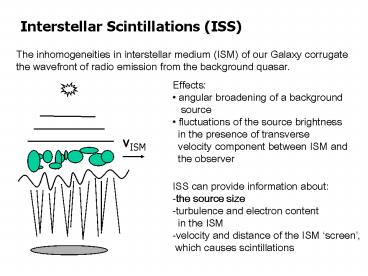Interstellar Scintillations ISS - PowerPoint PPT Presentation
1 / 4
Title:
Interstellar Scintillations ISS
Description:
Two broad-band branches for strong and weak scattering of the background radiation. One narrow-band branch strong diffractive scintillation (for extremely small ... – PowerPoint PPT presentation
Number of Views:91
Avg rating:3.0/5.0
Title: Interstellar Scintillations ISS
1
Interstellar Scintillations (ISS)
The inhomogeneities in interstellar medium (ISM)
of our Galaxy corrugate the wavefront of radio
emission from the background quasar.
- Effects
- angular broadening of a background
- source
- fluctuations of the source brightness
- in the presence of transverse
- velocity component between ISM and
- the observer
vISM
ISS can provide information about -the source
size -turbulence and electron content in the
ISM -velocity and distance of the ISM screen,
which causes scintillations
2
Features of Interstellar Scintillation
Two broad-band branches for strong and weak
scattering of the background radiation One
narrow-band branch ? strong diffractive
scintillation (for extremely small sources like
pulsars)
A characteristic peak in the strength of
brightness fluctuations appears around a
critical frequency when a characteristic scale
of scattering, qscatt equals to the first
Fresnel zone
q F(l/2pL)0.5 where L is a
distance between the observer and the scattering
screen
3
Modulation index spectrum for IDV source, PKS
0405-385
Strong Weak scattering region
The one-parameter theoretical fit for the
expected scintillation behaviour.
Transition frequency between the strong and weak
scattering
The source size
Timescale t q L / v
Solve for L, v, q
4
How do we know that IDV sources scintillate?
- We observe the time delay in the variability
pattern observed by two widely separated
telescopes. Such time delay allows to measure the
transverse component of ISM velocity in the
direction of baseline formed by the two
telescopes.
2. We found an annual change in variability
timescales of IDV sources due to the changing
transverse component of the Earth orbital velocity

